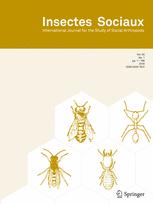Ver ítem
- xmlui.general.dspace_homeCentros e Institutos de InvestigaciónCICVyA. Centro de Investigación en Ciencias Veterinarias y AgronómicasInstituto de GenéticaArtículos científicosxmlui.ArtifactBrowser.ItemViewer.trail
- Inicio
- Centros e Institutos de Investigación
- CICVyA. Centro de Investigación en Ciencias Veterinarias y Agronómicas
- Instituto de Genética
- Artículos científicos
- Ver ítem
Expression analysis of genes putatively associated with hygienic behavior in selected stocks of Apis mellifera L. from Argentina
Resumen
Hygienic behavior is an economically beneficial, heritable trait, which has evolved to limit the impact of honeybee pathogens. Selecting and breeding colonies with high levels of hygienic behavior has become a feasible and environmentally friendly strategy to control brood diseases in honeybee colonies worldwide. The identification of genes involved in the expression of this character may not only unravel molecular and biochemical pathways underlying
[ver mas...]
Hygienic behavior is an economically beneficial, heritable trait, which has evolved to limit the impact of honeybee pathogens. Selecting and breeding colonies with high levels of hygienic behavior has become a feasible and environmentally friendly strategy to control brood diseases in honeybee colonies worldwide. The identification of genes involved in the expression of this character may not only unravel molecular and biochemical pathways underlying hygienic behavior, but also serve as a practical approach to select disease resistance biomarkers useful for honeybee breeding programs. In the present work, we evaluated, at genetic level, Apis mellifera stocks selected for hygienic behavior, widely used for commercial apiculture in Argentina. We analyzed the expression profiles of five genes previously identified as candidates associated with hygienic behavior both in QTL and global gene expression studies in honeybees, more precisely, involved in perception and processing of olfactory information. We validated the differential expression of these genes as potentially responsible for behavioral differences in our selected stocks. Our results indicate that four of them (octopamine receptor, smell-impaired, odorant-binding protein 3, and odorant-binding protein 4) were differentially expressed between hygienic and non-hygienic bees within our highly hygienic colonies. The present findings improve our understanding of the molecular mechanisms underlying the differentiation of middle-age worker bees in their genetic propensity to perform hygienic behavior. This progress towards the genetic characterization of highly hygienic colonies that are commercially used in Argentine apiculture lays the groundwork for future development of targets for marker-assisted selection of disease-resistant honeybee stocks.
[Cerrar]

Fuente
Insectes sociaux 64 (4) : 485–494. (November 2017)
Fecha
2017-11
ISSN
0020-1812 (Print)
1420-9098 (Online)
1420-9098 (Online)
Formato
pdf
Tipo de documento
artículo
Palabras Claves
Derechos de acceso
Restringido
 Excepto donde se diga explicitamente, este item se publica bajo la siguiente descripción: Creative Commons Attribution-NonCommercial-ShareAlike 2.5 Unported (CC BY-NC-SA 2.5)
Excepto donde se diga explicitamente, este item se publica bajo la siguiente descripción: Creative Commons Attribution-NonCommercial-ShareAlike 2.5 Unported (CC BY-NC-SA 2.5)

